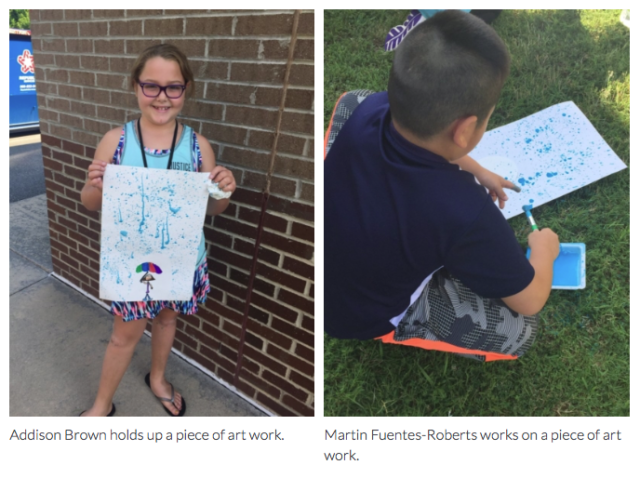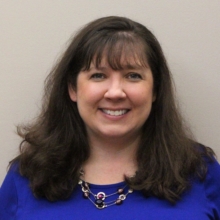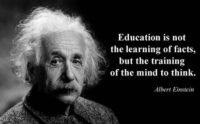
Students Caden Ward, Amya Washington, Joshua Gage, Cheyenne Waller and McKenzie Frye engage in a computer activity.
“Some kids are art smart, or music smart, or book smart, and we don’t get to explore enough of that during a traditional school day,” says Kerry Blackwelder, a veteran Read to Achieve third-grade HillRAP instructor. “I get excited for the kids who are coming to camp because this environment helps build their confidence so much and they blossom! They discover how smart they are and what they can accomplish.”
Read to Achieve Camp is designed to help third-graders meet state requirements in reading to advance to the fourth grade. The intensive four-week camp also includes first- and second-graders who demonstrated the potential for reaching grade-level proficiency in reading with extra help in the summer.
Davie County’s camp is based on the A+ Schools of North Carolina Program which combines interdisciplinary teaching and daily arts instruction to offer children opportunities to develop creative and innovative ways of thinking, learning, and showing what they know.
This is the fifth year the camp, partially funded by the Mebane Foundation, has employed this holistic approach to reading. The camp’s attendees actively learn through visual arts, drama, music, and creative writing, in addition to tailored instruction through Hill Center reading sessions and small group literacy circles. Each week has a different theme with most activities revolving around that topic reinforcing student understanding.
Eager to personally observe the transformation that I have been hearing and writing about for the past three years, as well as curious about the use of the arts to enhance literacy, I spent a day shadowing students from Lori Culler’s third-grade class and participating in their activities.
What a difference 11 days made! Students who were nervous and reluctant to be there when I spoke to them on the first day of camp were now fully engaged and begged to stay a little longer before going home. After enjoying a day of camp, I understood why.
8 a.m.- 8:20 a.m. — Gym
Third-graders begin in the gym with 20 minutes of stretching and exercise which gets the blood moving and the creative juices flowing, according to Camp Director, Jeremy Brooks. “This morning tradition also helps to create a sense of community as we actually become a little family for the summer.”
After completing several child-oriented exercise and music videos that were enough to get the heart pumping and the stomach growling, students went to the cafeteria to pick up breakfast to carry back to homeroom.
8:25 a.m.- 8:50 a.m. – Homeroom
While students ate, Culler read Cloudy With a Chance of Meatballs, a fun fantasy about the town of Chewandswallow where food falls from the sky three times a day; for breakfast, lunch, and dinner. The story tied into the week’s theme of weather as did yesterday’s story, Thunder Cake, in which a grandmother helps her granddaughter get over her fear of thunder by making a cake together. Students excitedly informed me that they would be making thunder cake the following day. (Yes, I was invited, and yes, it was delicious. Thanks, Mrs. Culler, Mrs. Alonso, and students!)
The story was followed by the morning meeting in which students greeted each other through a series of rotations that included a “good morning,” along with a handshake, curtsy or bow, high five, or fist bump.
“We have students from all of the elementary schools in our group of 15,” said Culler. “We wanted to build a feeling of community and belonging. Students who came in on the first day of camp not knowing anyone suddenly have 14 new friends.”
Homeroom ended with videos about hurricanes and a discussion about tropical storm Chris which had just been upgraded to a hurricane.
8:55 a.m. – 9:40 a.m. – HillRAP
Arnulfo, Joshua, Sophia and I headed to a Hill Center reading session with Suzie Alonso who has been teaching HillRAP in the classroom for three years and at RtA Camp for the past three summers.
Through HillRAP, specially trained teachers guide groups of up to four students through exercises in phonological awareness, phonics, fluency, vocabulary, and comprehension. Each student has an individualized curriculum to provide instruction where it is needed most. Using an iPad, students complete a series of literacy-focused activities. Alonso’s iPad links to each student’s iPad so that she can check their answers as well as go around the table and work with students individually.
“The program helps students understand and practice phonics through learning the syllable types, decoding words, and practicing reading fluency,” Alonso said. “The students then use the words that they have decoded in context by reading passages and answering questions. HillRap is a valuable program in that it meets each child at their level of reading. The program also has the students work towards a goal and work against themselves.”
9:45 a.m – 10:30 a.m. – Art
We headed to Art for more weather-related activities with Amanda Juhasz, Esther LaRoque, and Mindy Ledbetter. Yesterday students drew a picture of a person standing under an umbrella. Today students went outside to splatter paint rain onto their pictures. For the second activity, Juhasz read a weather-related poem entitled Today We Had Some Weather. Students created three-column booklets in which they illustrated three idioms from the poem, “It was raining cats and dogs” was a group favorite.
“When viewing artwork, students must learn to look closely in order to comprehend different aspects of the work,” said Juhasz. “In learning to look closely (visual literacy), they also learn how important it is to “look” more closely when reading text. Skills learned when viewing artwork help students with comprehension and support ELA standards.”
 “The theme for third grade this particular week was the weather. Students drew rainy-day portraits of people holding umbrellas. Earlier in the week, they watched a video about Jackson Pollock and his interesting splatter painting technique. Students looked closely at some of Pollock’s artwork and then used his technique to splatter paint rain in their pictures.”
“The theme for third grade this particular week was the weather. Students drew rainy-day portraits of people holding umbrellas. Earlier in the week, they watched a video about Jackson Pollock and his interesting splatter painting technique. Students looked closely at some of Pollock’s artwork and then used his technique to splatter paint rain in their pictures.”
“In the art room, the weather poem that was introduced in their homeroom was used to point out idioms,” she added. “Idioms are difficult for some students to understand, but when we illustrate them, the literal meaning becomes clear, and students were encouraged to share with each other the literal meaning in order to decipher the figurative meaning of each.”
When given time to discuss either works of art or their idioms, teachers used guiding questions that led to a deeper understanding of ELA and Art concepts.
10:35 a.m. – 11:20 a.m. – Reading
Culler reviewed the elements of poetry that she had already introduced including rhythm, repetition, alliteration, rhyme, and onomatopoeia. Today she added personification and reinforced the definition of idioms, everyday phrases that don’t make sense, but we know what they mean. Students practiced reading the weather poem from art class using little shakers to help maintain the proper rhythm.
“Reciting poetry with a musical instrument helps to build a reader’s fluency,” said Culler. “Fluent readers are able to focus on the meaning of the text because they are not having to spend time decoding words.”
Students then glued the stanzas of the poem onto the pages of a popsicle book (a small paper booklet with a large popsicle stick as the spine) and illustrated them. According to Culler, this offered students who are art smart a chance to show their understanding of the poem as well as gave students something to take home to show to parents and siblings.
11:25 a.m. – 11:35 – Homeroom
Students are getting tired by this time, so Culler uses short, fun but educational activities to keep them moving. We sang My Bonnie Lies Over the Ocean and stood or sat whenever we heard the “b” sound. We also answered the question, “If you could make one rule that the world has to follow, what would be your rule?” Then it was time for a bathroom break before recess.
11:35 a.m. – 12:05 – Recess
YMCA counselors Olivia Bowman and Jay Davis took the students to the Rich Park playground to work off some of their abundant energy.
“Our partnership with the YMCA allows teachers to have a planning time each day,” said Brooks. “Our entire third-grade team eats lunch together. This working lunch has sparked many great ideas and has been the origin of many of our camp’s traditions.”
12:10 p.m. – 12:35 p.m – Lunch
After working up a thirst and an appetite, students visited together while eating lunch also supervised by Bowman and Davis.
12:35 p.m. – 1:05 p.m. – Computer Lab
Under the supervision of Rachel Morse, students used i-Ready software to practice for next week’s end-of-camp assessment. Students completed exercises that helped them read to understand, read to analyze, and read to write. The i-Ready software package delivers student instruction, performance diagnostics and progress reports based on K-12 Common Core State Standards (CCSS) in Mathematics and Reading. Students took the i-Ready Diagnostic Test and receive differentiated online instruction according to their ability, while camp instructors receive customized reports on student performance and progress throughout camp. The state accepts the i-Ready Assessment as an alternative to the standard end of grade (EOG) test.
“The i-Ready program helps students by giving them a fun way to learn reading skills,” said Morse. “It’s engaging and provides rewards for their hard work. I love that they can have fun and learn at the same time.”
1:10 p.m. – 1:55 p.m. – Music
Rhythm ruled the day in music class. After a discussion of fiction vs. non-fiction, Michael Errickson guided students through reading the words of a song using the proper rhythmic phrasing. Students clapped their hands, tapped their legs, and used musical instruments to reinforce the rhythm. He then divided them into groups with different parts. The lesson culminated with each group doing their part simultaneously.
“The science behind multiple intelligences and their use as teaching tools has grown in acceptance and practice in the classrooms across the globe,” said Errickson. “Music has shown great potential to aid students in the acquisition of skills and concepts in a ‘whole brain’ learning style and has facilitated the expansion of knowledge not only of music’s own content but also that of other academic areas.”
“In this lesson, rhythm was used to reinforce the elements of fiction/non-fiction stories in a fun and engaging way,” he added. “Developing rhythmic accuracy increases the likelihood of success with phonemic awareness and potentially with accuracy and fluency. It also affords students with an opportunity to express themselves and demonstrate their understanding of concepts with or without using language itself.”
2:00 p.m. – 2:40 p.m. – Homeroom
Part of homeroom involved the completion and a review of the day’s events. Culler reviewed the weather poem, and students recited it with shakers again as a whole class.
Students finished the illustrations in their popsicle books while Culler read a Patricia Polacco book entitled Something About Hensley’s.
“I put a lot of focus on Polacco’s books during this week because she was a struggling reader in grade school and had to work hard to overcome that obstacle and now she is a children’s writer!” said Culler. “I want my students to see that being a struggling reader does not prevent you from being successful in life.”
Some students chose to share their drawings with their classmates during the daily “informance,” (impromptu performances that require no rehearsals). At 2:35, it was time to line up to go.
At the end of the day, it was easy to see why the camp is such a success. Passionate, dedicated teachers + a dynamic multi-faceted curriculum = thriving, confident students ready to take on the challenges that a new school year will bring.
Written by Jeanna White for EdNC ~ July 25, 2018
 ~ the Author ~
~ the Author ~
Jeanna White is a writer for the Mebane Charitable Foundation in Mocksville. Ten years as a substitute teacher for students from preschool through high school has given her a unique perspective and passion for education. White graduated from the University of North Carolina at Chapel Hill with a degree in Journalism.
 ~ Afterword ~
~ Afterword ~
Lost in this feel good propaganda piece benefiting the NC Department of Education is the tragic fact that these children are in reading camp because the schools failed to teach them how to READ. These kids don’t need I-pads and painting Instruction, they need a McGuffy Reader and someone who understands how to teach using Phonics. The only question that is important to the future of your children is why has Superintendent Johnson and the NC Board of Education continued to use the inferior sight word reading method to teach reading? You are going to have to get involved in the education of your children. You are going to have to vote your school boards out until they get the message. To save America we must save one child at a time. Join the cause. Invite a friend. ~ Rosemary Stein, MD
 FAIR USE NOTICE: This site contains copyrighted material the use of which has not always been specifically authorized by the copyright owner. We are making such material available in our efforts to advance understanding of environmental, political, human rights, economic, democracy, scientific, and social justice issues, etc. We believe this constitutes a ‘fair use’ of any such copyrighted material as provided for in section 107 of the US Copyright Law. In accordance with Title 17 U. S. C. Section 107, the material on this site is distributed without profit to those who have expressed a prior interest in receiving the included information for research and educational purposes. For more information go to: http://www.law.cornell.edu/uscode/17/107.shtml
FAIR USE NOTICE: This site contains copyrighted material the use of which has not always been specifically authorized by the copyright owner. We are making such material available in our efforts to advance understanding of environmental, political, human rights, economic, democracy, scientific, and social justice issues, etc. We believe this constitutes a ‘fair use’ of any such copyrighted material as provided for in section 107 of the US Copyright Law. In accordance with Title 17 U. S. C. Section 107, the material on this site is distributed without profit to those who have expressed a prior interest in receiving the included information for research and educational purposes. For more information go to: http://www.law.cornell.edu/uscode/17/107.shtml
